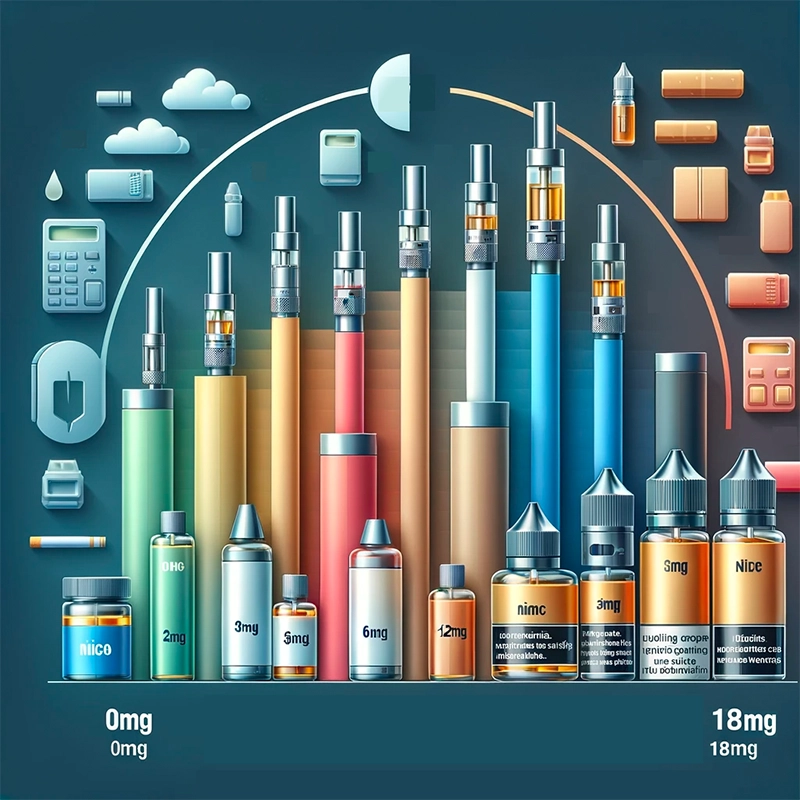Vaping Nicotine Strengths Guide: Everything You Need to Know
Vaping has become increasingly popular in recent years as a way to transition from smoking to a less harmful alternative. One of the most important factors to consider when vaping is the nicotine strength. Understanding nicotine strengths is crucial to ensure a smooth transition from smoking to vaping and to avoid unpleasant symptoms such as headaches, dizziness, and nausea.
Nicotine strength refers to the concentration of nicotine in e-liquid, usually measured in milligrams per millilitre (mg/ml) or as a percentage. Most e-liquids come in a variety of nicotine strengths, ranging from 0mg to 20mg which is the legal limit in the UK. Choosing the right nicotine strength depends on several factors, including smoking habits and the type of device being used. It is important to note that nicotine salts, a newer form of nicotine, have a higher concentration of nicotine and can provide a stronger nicotine hit than traditional e-liquids.
Contents
Key Takeaways
- Understanding nicotine strengths is crucial for a smooth transition from smoking to vaping.
- Nicotine strength is measured in milligrams per millilitre (mg/ml) or as a percentage.
- Choosing the right nicotine strength depends on smoking habits and the type of device being used.
Understanding Nicotine Strengths
When it comes to vaping, nicotine strength is an important factor to consider. Nicotine strength is typically measured in milligrams per millilitre (mg/ml) and indicates the concentration of nicotine in your e-liquid. The higher the nicotine strength, the stronger the throat hit and the more nicotine you will consume with each puff.
Nicotine strengths can vary depending on the brand and type of e-liquid. Some e-liquids use nicotine salts, which can provide a smoother vaping experience and a quicker nicotine hit compared to traditional freebase nicotine. Nicotine salts are usually available in higher strengths, up to 50mg/ml, while freebase nicotine typically ranges from 0mg/ml to 18mg/ml.
When choosing a nicotine strength, it’s important to consider your smoking habits and nicotine tolerance. Vapers who were heavy smokers may benefit from higher nicotine strengths, while those who smoked less may prefer lower strengths. As a general rule, a higher nicotine strength is recommended for those who are trying to quit smoking.
Here’s a breakdown of common nicotine strengths and the corresponding milligrams of nicotine per millilitre:
| Nicotine Strength (%) | Nicotine per Millilitre (mg/ml) | Suitable For |
|---|---|---|
| 0.0% | 0 mg/ml | Contains no nicotine |
| 0.3% | 3 mg/ml | Light smokers or reducing intake |
| 0.6% | 6 mg/ml | Light to moderate smokers |
| 1.2% | 12 mg/ml | Moderate smokers |
| 1.8% | 18 mg/ml | Heavy smokers |
| 2% | 20mg/ml | The heaviest of smokers. (Legal TPD Nicotine Limit) |
It’s important to note that nicotine strength is not the only factor that affects your vaping experience. Other factors such as the type of device, coil resistance, and airflow can also impact the amount of nicotine you consume with each puff.
Choosing the Right Nicotine Strength
Choosing the right nicotine strength is crucial for a satisfying vaping experience. Nicotine is one of four ingredients in vape juice, and it determines the strength of your throat hit and the satisfaction you get from vaping. A smoker’s transition from smoking to vaping depends on finding the right nicotine strength that satisfies their cravings without being too harsh.
Nicotine strength is measured in milligrams per millilitre (mg/ml) or as a percentage of the total volume of the e-liquid. The most common nicotine strengths are 0mg, 3mg, 6mg, 12mg, 18mg and 20mg/ml. Heavy smokers may require higher nicotine strengths, while light smokers may opt for lower nicotine strengths.
Nicotine salts are an alternative to traditional nicotine that are absorbed more quickly and provide a smoother throat hit. Nicotine salts are available in higher concentrations, typically between 10mg to 20mg/ml. Vapers who prefer a stronger throat hit and faster nicotine absorption may find nicotine salts more satisfying.
While in other countries nicotine salt concentrations can reach up to 50mg/ml, in the UK and EU, the limit is capped at 20mg/ml due to Tobacco Products Directive (TPD) regulations.
The type of device being used can also affect the nicotine strength required. Mouth-to-lung (MTL) devices require less nicotine strength than direct lung (DL) devices. Vapers who prefer MTL devices may find lower nicotine strengths more satisfying, while DL vapers may prefer higher nicotine strengths.
Ultimately, the choice of nicotine strength depends on the vaper’s preference and smoking habits. Smokers who are trying to quit smoking may find that gradually reducing their nicotine content over time helps them transition to vaping.
In summary, choosing the right nicotine strength is essential for a satisfying vaping experience. The nicotine content and concentration, device type, and smoking habits all play a role in determining the ideal nicotine strength. Vapers should experiment with different nicotine strengths to find the one that satisfies their cravings without being too harsh.
Understanding E-Liquids and Devices
When it comes to vaping, understanding e-liquids and devices is crucial. E-liquids are the liquids used in vaping devices to produce vapour. They typically contain a mixture of propylene glycol (PG) and vegetable glycerin (VG), along with flavourings and nicotine in varying strengths measured in milligrams per millilitre (mg/ml). PG is known to provide a stronger throat sensation, while VG is responsible for producing larger clouds of vapour.
Vaping devices come in different types, including vape pens, sub-ohm devices, and MTL (mouth-to-lung) devices. Sub-ohm devices are designed to produce larger clouds of vapour, and they work best with e-liquids that have a higher VG content. MTL devices, on the other hand, are designed to mimic the sensation of smoking, and they work best with e-liquids that have a higher PG content.
When choosing an e-liquid, it’s important to consider the nicotine strength. Nicotine strength is measured in mg/ml, and it determines the amount of nicotine delivered during vaping. It’s important to find the right balance of nicotine strength to suit individual preferences and needs. Experimenting with different strengths can help vapers find the ideal balance.
It’s also important to note that the aerosol produced by vaping is not smoke. It’s a mixture of water vapour, flavourings, and nicotine. Vaping is often considered a discreet alternative to smoking, as it produces less odour and is less harmful to others.
Health Implications of Nicotine
Nicotine is a highly addictive substance found in tobacco plants. It is also the primary ingredient in most vaping liquids. When inhaled, nicotine provides a quick rush of pleasure and a feeling of relaxation. However, it also has several health implications that vapers should be aware of.
Nicotine Strengths
The nicotine strength of a vaping liquid is measured in milligrams per millilitre (mg/mL). The most common nicotine strengths are 3mg/mL, 6mg/mL, 12mg/mL, and 18mg/mL. Heavy smokers may require higher nicotine strengths to satisfy their cravings, while new vapers may prefer lower nicotine strengths to avoid side effects such as headaches and nausea.
Side Effects
Nicotine can cause several side effects, including dizziness, nausea, and headaches. These symptoms are usually temporary and go away after a few minutes. However, heavy smokers or new vapers may experience more severe symptoms, such as coughing and throat irritation.
Children and Pets
Nicotine poisoning is a serious concern for children and pets. Vaping liquids should be kept out of reach of children and pets at all times.
Smoking Habits
While vaping is generally considered less harmful than smoking cigarettes, it is not without risks. Vapers should be aware of the potential health implications of nicotine and take steps to minimise their exposure. Quitting smoking altogether is the best way to reduce the risk of developing smoking-related illnesses.
Transitioning from Smoking to Vaping
Transitioning from smoking to vaping can be a challenging process, but it is possible with the right approach. Vaping provides a similar experience to smoking, but with fewer harmful chemicals and toxins. The key to a successful transition is finding the right nicotine strength and device for your needs.
When transitioning from smoking to vaping, it’s important to start with a nicotine strength that matches your current smoking habits. Heavy smokers may require a higher nicotine concentration, while light smokers may prefer a lower concentration. Nicotine strengths are typically measured in milligrams per millilitre (mg/ml) and range from 0mg/ml to 20mg/ml.
Vapers can choose from a variety of devices, including pod systems, vape pens, sub-ohm devices, and more. Mouth-to-lung (MTL) devices are designed to mimic the sensation of smoking, while direct lung (DL) devices produce larger clouds of vapour. New vapers may want to start with a MTL device to ease the transition.
One important factor to consider when choosing an e-liquid is the nicotine content. Freebase nicotine is commonly found in e-liquids and provides a strong throat hit, while nicotine salts are smoother and more satisfying. Nicotine salts are a good choice for heavy smokers or those who experience strong cravings.
It’s also important to choose an e-liquid with a flavour that suits your preference. Flavours range from traditional tobacco to fruity and sweet options.
When transitioning from smoking to vaping, it’s common to experience symptoms such as coughing, nausea, and dizziness. These side effects should subside within a few days as the body adjusts to the new nicotine delivery system. Vapers should also be aware of the potential risks of nicotine poisoning, especially when using high-strength e-liquids or leaving bottles within reach of children or pets.
Overall, transitioning from smoking to vaping requires patience and experimentation. Vapers should be prepared to try different devices, e-liquids, and nicotine strengths to find what works best for their individual needs. With the right approach, vaping can be an effective tool for quitting smoking and improving overall health.
Frequently Asked Questions
What is the difference in nicotine levels between vaping and smoking?
How much nicotine is considered a high amount in vaping?
What is the recommended nicotine strength for new vapers?
Can vaping with high nicotine levels be harmful?
How much nicotine is in one puff of a vape?


Leave a Reply